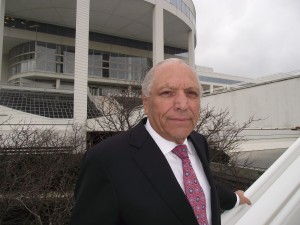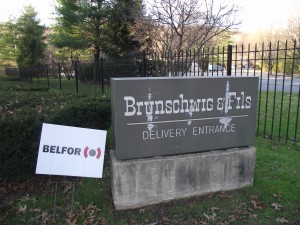
Business owner Olivier Peardon keeps a brass plaque in his loft office in Port Chester that is a treasured relic of his family and business heritage. “Brunschwig & Fils Inc.,” the engraving reads. “To the Trade Only.”
Until this year, when the once-thriving company”™s assets were sold in a U.S. Bankruptcy Court auction, Peardon represented the fourth generation in his family to head Brunschwig & Fils, a luxury fabrics company that served designers in the high-end home decorating industry from showrooms in the U.S. and abroad. He has continued in the design trade as the head of Hinson & Co., a fabrics, wall coverings and lighting business that he and his father acquired two years ago to expand Brunschwig”™s market reach and save the company that had been their family”™s business since 1900, first in France and most recently in North White Plains.

But the Brunschwig & Fils brand now is owned by Kravet Inc., a to-the-trade home furnishings company in Bethpage, Long Island. About 60 jobs were lost in Westchester with the closing this year of Brunschwig”™s headquarters and warehouse operations at 75 Virginia Road. Kravet, whose initial stalking-horse bid for the company”™s assets was $6.5 million, in March paid about $10 million at a bankruptcy auction.
At its peak, Brunschwig & Fils had about 125 employees in North White Plains, where it moved from Manhattan in 1984 after buying a former car dealership building, Pearson said. Leasing 18 showrooms, it at one time had 325 employees in all.
“The company catered to the 1 or 2 percent of the world at the very high end of luxury decorating,” Peardon said. “The company was a very, very rich company for very many years.”

“Brunschwig & Fils is a classic case” in business bankruptcy, said Charles D. Benjamin, CEO of Benjamin Capital Advisors in Rye Brook. A specialist in business bankruptcies, turnarounds and restructurings, Benjamin was retained by the Peardons as the creditor-beleaguered company prepared to file for bankruptcy.
“I save companies. That”™s really what I do,” said Benjamin, who works largely with privately held companies with $50 million to $300 million in annual revenue. “My job is to save companies, because that works for both the debtor and the creditor.”
“Businesses that fail have to have had success,” he said. “Sometimes the very reasons that caused their success ultimately cause their failure. They”™re like a deer in headlights sometimes and they don”™t know how to change with the times.”
At Brunschwig & Fils, changes made to adjust to a shrinking market for classic luxury design had proven costly.
“From the mid-1990s to 2004, we about doubled our square footage in showrooms, which ultimately was the kiss of death, because we sure didn”™t double our sales,” said Peardon, who became company president in 2007. Leases structured favorably for the tenant at the start became more expensive over the years.
“Here”™s a company with 26 showrooms in major cities around the world ”“ fixed costs,” Benjamin said.
When a new designer joined the company in 2005, Brunschwig began to move away from the high-end market where it had made its name over a century.
“Instead of concentrating at the highest level, we started to go down the pyramid, but using the same brand name. In the business world, that”™s suicide.”
Brunschwig began producing fabrics that could compete in the lower market, but could not compete in price with the products of its new market competitors. “Our gross margins diminished considerably,” Peardon said.
“Design, loss of focus, an overhead that we really couldn”™t negotiate ourselves out of. Throw in the depression and the three of them just killed us.”
Benjamin, the second crisis consultant hired by Brunschwig since 2007, did an initial financial analysis. “He said, ”˜This company isn”™t ready for bankruptcy,”™” Peardon recalled. “We decided to do some clever things to avoid bankruptcy.”
Among the cost-cutting measures, the company struck an air shipment deal with UPS that saved it more than $800,000 a year in shipping costs.
In 2009, it signed on with a professional employer organization, New Jersey-based Automatic Data Processing Inc., to take over its human resources and other administrative services. “Our employee benefits plan was completely out of line with the realities of other business plans in the area,” Pearson said. ADP cut about $2.5 million annually in insurance costs.
In the fall of 2008, as the nation fell into the recession, Brunschwig sold its 87,000-square-foot building in North White Plains to eliminate its debt with JP Morgan Chase. The lender was exiting the housing industry, a move that affected both Brunschwig and its suppliers. Brunschwig leased back 50,000 square feet in the building.
But the buyers, led by Diamond Properties in Mount Kisco, were unable to close as scheduled on financing for the deal. The closing was delayed for 20 months, Peardon said. “Essentially we got our big chunk of cash two years after we would have liked to have had it. It might have made a difference, it”™s hard to tell.”
At the close of 2009, Peardon and his father, Thomas, bought Hinson & Co. to add its upper-middle-market brand to Brunschwig showrooms. No bank would lend to Brunschwig & Fils for the purchase. The separate purchase by the Peardons left Hinson & Co. outside the bankruptcy auction.
“It was a very, very good match and it worked very well,” Peardon said of the purchase. “It unfortunately didn”™t work well enough for Brunschwig.”
Heavily pressured by creditors, “We just ran out cash, basically, and we weren”™t able to borrow it”¦Essentially our supply chain dried up.”
The bankruptcy has been costly to the company”™s creditors. Peardon said the fee for the Manhattan bankruptcy firm representing Brunschwig will be about $1 million. “If you don”™t pay them, you go quickly from Chapter 11 to Chapter 7” and liquidation.
“The shame of it is that the professionals eat up so much money,” he said. “Creditor committees hire their own Chuck Benjamins.”
“You have to prepare your filing in enormous advance and especially in a company of this size, you have to build a war chest just to go in the bankruptcy.”
“The cost of bankruptcy is just enormous,” Benjamin said. “The unsecured creditors committees have been given very broad power. It”™s made the bankruptcy process complex and very expensive”¦The process for smaller companies just gets too expensive.”
“The other problem with Chapter 11 today is the principals almost always lose the company. In the old days they could save the company and stay in business.”
For Peardon, the bankruptcy sale was the last measure to save Brunschwig & Fils when its founder”™s descendants could no longer save it on their own.
“You do everything you can to preserve the brand and its history. That”™s what we did by selling it to the Kravets.”
The emotional attachment and the family mementos bearing the Brunschwig name stay with him.
“It”™s part of my DNA. I grew up with it,” Peardon said. “I think about it a lot in the sense, is there anything I could have done differently?
“For now, the answer is no. I think I exhausted everything I could have done for that brand.”





















